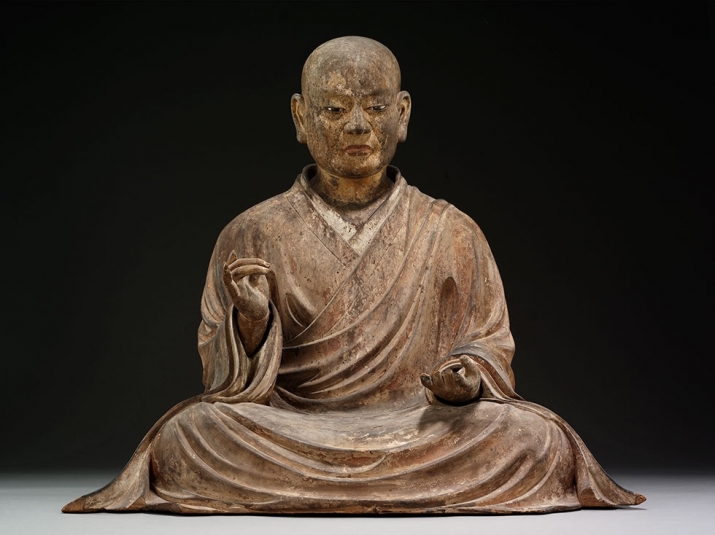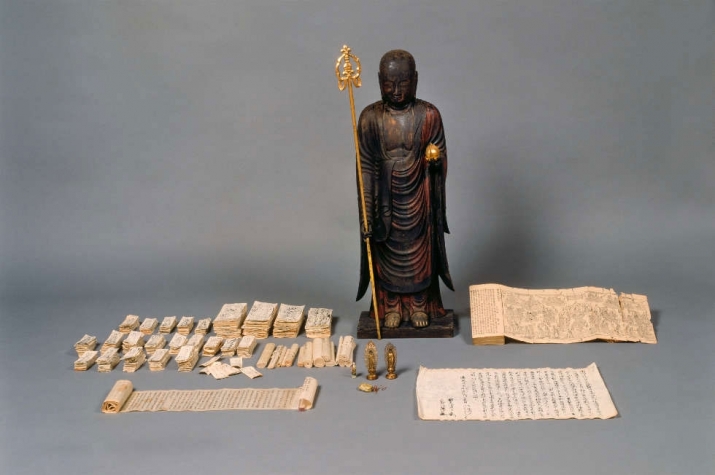NEWS
Asia Society Holds Landmark Exhibition of Sculptures from Japan’s Kamakura Period in NYC
 The Shinto deity Hachiman in the guise of a Buddhist monk, 1328. From asiasociety.org
The Shinto deity Hachiman in the guise of a Buddhist monk, 1328. From asiasociety.orgAs part of its “Season of Japan” celebration of Japanese culture, the Asia Society in New York is hosting a landmark exhibition titled Kamakura: Realism and Spirituality in the Sculpture of Japan. Comprising Buddhism-inspired masterpieces from private and museum collections in North America and Europe, the exhibition coincides with the 60th anniversary of the Asia Society, which was founded in 1956 by John D. Rockefeller III.
The works on display all originate from Japan’s Kamakura period (1185–1333), which, as well as being known for the emergence of the samurai warrior caste and the establishment of feudalism in Japan, is notable for the flourishing of Buddhism across the country—in particular Zen Buddhism and the Jōdo-shū branch of Pure Land Buddhism. This politically and socially turbulent period was also a high point in the history of Japanese sculpture, as artists began incorporating stylistic and technical innovations that resulted in a level of realism not previously seen. Sculptors of the era also began signing their work, enabling the evolution of styles by individuals and workshops to be traced and documented. Sculptors in the 18th century could trace their artistic lineages back to early Kamakura masters.
The exhibition has been organized by art historian Ive Covaci and Adriana Proser, the Asia Society Museum’s curator of traditional Asian art. “While many larger institutions and private collections have a few works from this period, it is rare to get to see these [works] together as a group,” said Covaci. “[Neither] the general public nor Asian art specialists have seen a major loan show of Kamakura sculpture in the United States in decades.” (The Art Newspaper)
The warrior clans of the period challenged Japan’s centuries-old imperial court, and in the devastating civil war of the 1180s, the Buddhist temples of the ancient capital Nara were burned to the ground. Buddhist artists and craftsmen began almost immediately to rebuild and repopulate the temples with new sculptures, devising new techniques and artistic styles in the process of regeneration. Renewed contact with Asia in the early Kamakura period also served to invigorate the arts and religious practices in Japan.
“The icons in this exhibition commanded the faith of passionate devotees, some of whom hoped to gain merit from the making of a Buddhist image, to ensure salvation in the afterlife, or to obtain tangible benefits in this life,” said the Asia Society in a statement. “Others aimed to achieve ultimate awakening through ritual unification with the deity represented by the icon. In their original contexts these powerful icons were ‘real presences,’ brought to life by their naturalistic form, ritual activation, and sacred interior contents.” (Asia Society)
 Statue of the bodhisattva Jizo by Koen, 1249. From nybook.com
Statue of the bodhisattva Jizo by Koen, 1249. From nybook.comOne section of the exhibition, titled “Empowering Interiors,” shows examples of the tradition of placing sacred objects and texts inside Buddhist statues. An image of Jizo Bosatsu by the sculptor Koen (1207–after 1275) is displayed with a collection of sacred items that were contained within, including an inventory compiled by a monk named Shaishin, who oversaw the sculpture’s consecration. The inventory lists “one grain of a Buddha relic, gilt-bronze images of Shakyamuni and Amida,” and “1,000 votive prints of Amida and Jizo.” (The New York Times)
Asia Society president and CEO Josette Sheeran said “Season of Japan,” which also includes films, talks, and performances, reflected the vision of society founder John D. Rockefeller III. “His first trip to Asia was to Japan and he, like countless others, fell in love with the country. Later in life he and his wife came to see Japan as a second home.” (NewYork.com)
The exhibition, which began on 9 February, is being held at the Asia Society Museum on Park Avenue (at 70th Street) until 8 May.
See more
Kamakura: Realism and Spirituality in the Sculpture of Japan (Asia Society)
On View: The Asia Society Celebrates a ‘Season of Japan’ (NewYork.com)
Asia Society Museum organises Japanese sculpture show—with no loans from Japan (The Art Newspaper)
Kamakura: Realism and Spirituality in the Sculpture of Japan at Asia Society Museum, February 9 – May 8, 2016 (Art Summary)
Spellbinding Treasures From Japan’s Kamakura Period at Asia Society (The New York Times)
Statues of Wrath and Serenity (The New York Review of Books)














